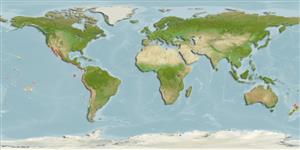>
Carangiformes (Jacks) >
Carangidae (Jacks and pompanos) > Trachinotinae
Etymology: Trachinotus: Greek, trachys, -eia, -ys = rough + Greek,noton = back (Ref. 45335).
More on author: Cuvier.
Environment: milieu / climate zone / depth range / distribution range
Ecologia
marino benthopelagico; distribuzione batimetrica 0 - 100 m (Ref. 122694). Subtropical; 35°N - 26°S, 121°W - 70°W
Eastern Pacific: Redondo Beach in southern California, USA to Chile, including the Galapagos Islands.
Size / Peso / Age
Maturity: Lm ? range ? - ? cm
Max length : 51.0 cm TL maschio/sesso non determinato; (Ref. 2850); common length : 30.0 cm TL maschio/sesso non determinato; (Ref. 55763)
Short description
Chiavi di identificazione | Morfologia | Morfometria
Body deep (less so with age) and strongly compressed; mouth small; jaw teeth small, villiform, and only slightly hooked, disappearing with age; lower branch of first gill arch with 8 to 10 gill rakers; dorsal fin with 6 spines followed by another spine and 24 to 27 soft rays (VI+I, 24-27); upper third of body dark; belly white; flanks with golden highlights; no distinctive marks (Ref. 55763).
Adults are found in coastal waters, usually forming schools in shallow inshore sandy areas (Ref. 9283). They feed on mollusks, crustaceans, other invertebrates and small fishes (Ref. 9283). Excellent for human consumption. Minimum depth range based on estimate; to be replaced with a better reference.
Life cycle and mating behavior
Maturità | Riproduzione | Deposizione | Uova | Fecundity | Larve
Eschmeyer, W.N., E.S. Herald and H. Hammann, 1983. A field guide to Pacific coast fishes of North America. Boston (MA, USA): Houghton Mifflin Company. xii+336 p. (Ref. 2850)
IUCN Red List Status (Ref. 130435: Version 2024-1)
Threat to humans
Harmless
Human uses
Pesca: scarso interesse commerciale
Strumenti
Special reports
Download XML
Fonti Internet
Estimates based on models
Preferred temperature (Ref.
123201): 17.7 - 28.3, mean 23.2 °C (based on 70 cells).
Phylogenetic diversity index (Ref.
82804): PD
50 = 0.5000 [Uniqueness, from 0.5 = low to 2.0 = high].
Bayesian length-weight: a=0.01202 (0.00693 - 0.02085), b=2.88 (2.72 - 3.04), in cm total length, based on LWR estimates for this species & (Sub)family-body (Ref.
93245).
Trophic level (Ref.
69278): 3.7 ±0.55 se; based on food items.
Resilienza (Ref.
120179): Medio, tempo minimo di raddoppiamento della popolazione 1.4 - 4.4 anni (Preliminary K or Fecundity.).
Fishing Vulnerability (Ref.
59153): Moderate vulnerability (40 of 100).
